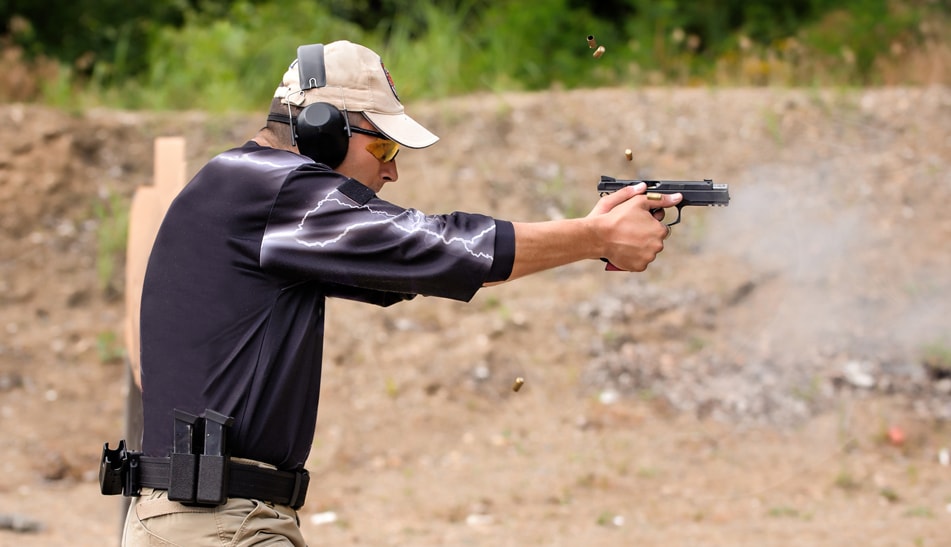If you’ve ever tried to shoot accurately …
Or you’ve been missing a target and you can’t figure out what in the HECK you’re doing wrong …
Then you’ve probably discovered the horrible concept of “flinching” when shooting and how it can totally mess up your shot!
Today, I’m going to introduce to you an idea that can almost completely eliminate flinching when shooting and do it practically overnight. Sound like a HUGE promise? Check it out:
What Is Flinching And Why Is It Such a Big, Bad Deal?
The fact is, that different trainers use different terms, so for this article I’m simply talking about any UN-intended human reactions or movement of your arms, hands, fingers, etc when you break a shot that causes the bullet to not go where your sights were aimed.
I recently read this article by Julie Golob and she says:
“Hello, my name is Julie Golob, and I flinch.
That’s right…I’m a professional competition shooter, a seven-division practical shooting ladies champion with over 50 world and national titles. How could I possibly flinch when I shoot?
Every now and again, though, you’ll see me flinch. It can happen when I am shooting cold, with no practice. It can happen when I know I will experience significant recoil. It can happen when I feel pressure to perform. My eyes may close just as I break the shot, but training, discipline, knowledge of my firearm and recoil control techniques result in a minor discrepancy of hits on the target… or a quick follow-up shot.
Flinching is a natural defense mechanism that plagues many shooters, and yes, even seasoned ones. A flinch is a natural human reaction, defined as a quick, nervous movement of the face or body as an instinctive reaction to surprise, fear, or pain.
When you shoot a firearm, there is literally an explosion happening inches in front of your face. It’s completely natural to slam your eyelids shut, tense up, and…flinch.”
To review …
Shooting accurately is simple.
Simple, but not necessarily easy 🙂
Like “The Great One”, Rob Leatham, says, these are the three secrets to shooting better:
1. Hold The Gun REALLY tight! We don’t have all day to line up our sights and take our time and because we may need to shoot multiple, fast, accurate follow-up shots — we need to hold the gun really tight.
2. Point the gun at the target where you wanna hit it (That means get the proper sight alignment and sight picture).
3. Pull the trigger without moving the gun and/or sights. And according to “The Great One” THIS is the most important part of the process and it has more to do with #1 (Gripping/Holding the gun) than it does #2 (aiming).
It’s number 3 that’s the problem for most all of us.
Breaking The Shot By Engaging The Trigger Without Disturbing The Sights Is The Most Important Part of Shooting!
Reading what Julie wrote, and thinking on the Great One’s thoughts, and then I recently was training with the “Mountain Guerrilla” John Mosby when we were talking about the unique way he runs drills at the range.
(This is the secret.)
You don’t flinch — or you will notice if you’re flinching — when you dry fire.
(Dry fire is of course shooting with NO bullets, just practicing the three steps of holding the gun, aiming the gun, and breaking the trigger with no shots fired.)
Yet, if you ONLY dry fire you never get used to real shooting …
And if you ONLY shoot live fire, you quickly develop a flinch without noticing it …
Which leads us to …
#1 Way To (Almost) Completely Eliminate Flinching When Shooting!
Combine dry fire and live fire in the same session.
I learned this simple — but brilliant — concept from John Mosby and it’s called the “5+1 Drill”:
The 5+1 Drill
It requires the shooter to perform five dry-fire iterations of an exercise for every single live-fire iteration.
This is useful beacuse it ensures you are practicing the exercise correctly, without performance inhibitions due to the flinch mechanism as a result of recoil aversion. It also allows you to ensure that you are not “jerking” the trigger, or otherwise interfering with your sight-picture as you break your shots.
In today’s reality of limited, extremely expensive ammunition sources, this is particularly beneficial, because for every single round you actually fire in training, you’ve performed a minimum of six practice repetitions of that shot. As the old saying goes, “The more you sweat in training, the less you’ll bleed in combat.”
This is a simple, but VERY effective way to train.
It will keep you from hammering away in live fire and training yourself to flinch, because you are practicing piss poor repetitions.
But it will also keep you from fooling yourself with a bunch of dry fire reps that feel and look “fast and accurate”, but really when you load up your gun and actually shoot at the same target, you are not hitting it!
The more and more I think about it, it’s the absolute BEST way to train any drill or shooting technique.
Give This a Try!
If you find yourself flinching at the range, or you simply can’t make progress on a certain aspect of your shooting … then give this simple concept a try.
I think you’ll find it helps! If you already do this or something like it then please leave a comment below.

